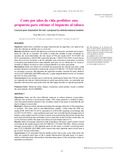Mostrar el registro sencillo del registro
Costo por años de vida perdidos : una propuesta para estimar el impuesto al tabaco
| dc.rights.licence | Atribución-NoComercial 4.0 Internacional | * |
| dc.contributor.author | Rosselli, Diego | |
| dc.contributor.author | Gil Tamayo, Sebastián | |
| dc.date.accessioned | 2020-03-31T18:13:40Z | |
| dc.date.accessioned | 2020-04-15T13:25:08Z | |
| dc.date.available | 2020-03-31T18:13:40Z | |
| dc.date.available | 2020-04-15T13:25:08Z | |
| dc.date.created | 2017-09-01 | |
| dc.identifier | https://revistas.unal.edu.co/index.php/revsaludpublica/article/view/60618 | spa |
| dc.identifier.issn | 0124-0064 / 2539-3596 (Electrónico) | spa |
| dc.identifier.uri | http://hdl.handle.net/10554/47985 | |
| dc.description.abstract | Objetivos Determinar y justificar la carga impositiva de los cigarrillos, con base en los años de vida que se pierden por su consumo. Métodos Mediante revisión de literatura se estimó la reducción promedio de la expec¬tativa de vida de un fumador. Se aplicó a cada año perdido el valor empleado en estudios de costo-efectividad, de tres veces el PIB per cápita (COP 16 613.951 de 2015, equivalentes a USD 6 056, aplicando tasa de 1 USD=2 743 COP). A partir de los años de consumo promedio, y de los paquetes que consume en ese lapso, se estimó el impuesto que debería tener cada paquete para que, con un interés de 3 % anual, el fumador al fallecer reuniera el valor correspondiente a los años que pierde. Resultados Dada una reducción promedio de esperanza de vida de seis años, cada fumador debería contribuirle al sistema de salud COP 299 051 115 (USD 109 008). Si en promedio consume 166 paquetes de cigarrillos anuales, durante 50 años, debería reunir COP 2.659 648 (USD 969) cada año, y cada paquete debería tener un impuesto de COP 16 022 (USD 5,84). Conclusiones Si se acepta que el sistema de salud pague hasta tres PIB per cápita por cada año de vida por intervenciones en salud que aporten años, es razonable que aquellas intervenciones que quitan años de vida hagan también un aporte equivalente. | spa |
| dc.format | spa | |
| dc.format.mimetype | application/pdf | spa |
| dc.language | spa | spa |
| dc.rights.uri | http://creativecommons.org/licenses/by-nc/4.0/ | * |
| dc.source | Revista de Salud Pública; Vol. 19 Núm. 5 (2017) | spa |
| dc.subject | Hábito de fumar | spa |
| dc.subject | Tabaco | spa |
| dc.subject | Impuestos | spa |
| dc.subject | Salud pública | spa |
| dc.subject | Costos y análisis de costo | spa |
| dc.title | Costo por años de vida perdidos : una propuesta para estimar el impuesto al tabaco | spa |
| dc.type | info:eu-repo/semantics/article | |
| dc.type.hasversion | http://purl.org/coar/version/c_ab4af688f83e57aa | |
| dc.description.quartilescopus | Q3 | spa |
| dc.title.english | Cost per year of potential life lost : a proposal to estimate tobacco taxation | spa |
| dc.identifier.doi | https://doi.org/10.15446/rsap.v19n5.60618 | spa |
| dc.description.tipoarticulo | Artículo de investigación | spa |
| dc.description.paginas | 591-594 | spa |
| dc.format.soporte | Papel / Electrónico | spa |
| dc.subject.keyword | Smoking | spa |
| dc.subject.keyword | Tobacco | spa |
| dc.subject.keyword | Taxation | spa |
| dc.subject.keyword | Public health | spa |
| dc.subject.keyword | Costs and cost analysis | spa |
| dc.description.abstractenglish | Objectives Taxes are the most effective measure to reduce tobacco consumption, although this remains a controversial matter. This study presents a method to deter¬mine and justify taxation based on the monetary value of the years of potential life lost due to tobacco consumption. Methods A literature review allowed estimating the average reduction of life expectancy in smokers. The value used in cost-effectiveness studies —three times the GDP per capita (COP 16 613 951 for 2015, equivalent to USD 6 056, applying an exchange rate of USD 1=COP 2743) — was applied to each year lost. Considering the average years of tobacco consumption and the number of packs consumed during that period, the tax that each pack should have was estimated in such a way that, by the time the smoker dies, he or she will have paid for the years lost with an annual interest rate of 3 %. Results Given an average reduction of life expectancy of 6 years, each smoker should contribute to the health system with COP 299 051 115 (USD 109 008). With an annual average consumption of 166 cigarette packs for 50 years, a smoker should pay each year COP 2 659 648 (USD 969), which means that each cigarette pack should have a tax of COP 16 022 (USD 5.84). Conclusions If it is accepted that the health system has to pay up to three times the GDP per capita for each year of life in health interventions that add years, it is reaso¬nable to think that those interventions that take away years of life should also make an equivalent contribution. | spa |
| dc.type.local | Artículo de revista | spa |
| dc.contributor.corporatename | Pontificia Universidad Javeriana. Facultad de Medicina. Departamento de Epidemiología Clínica y Bioestadística |
Ficheros en el registro
Este registro aparece en la(s) siguiente(s) colección(ones)
-
Artículos [682]


